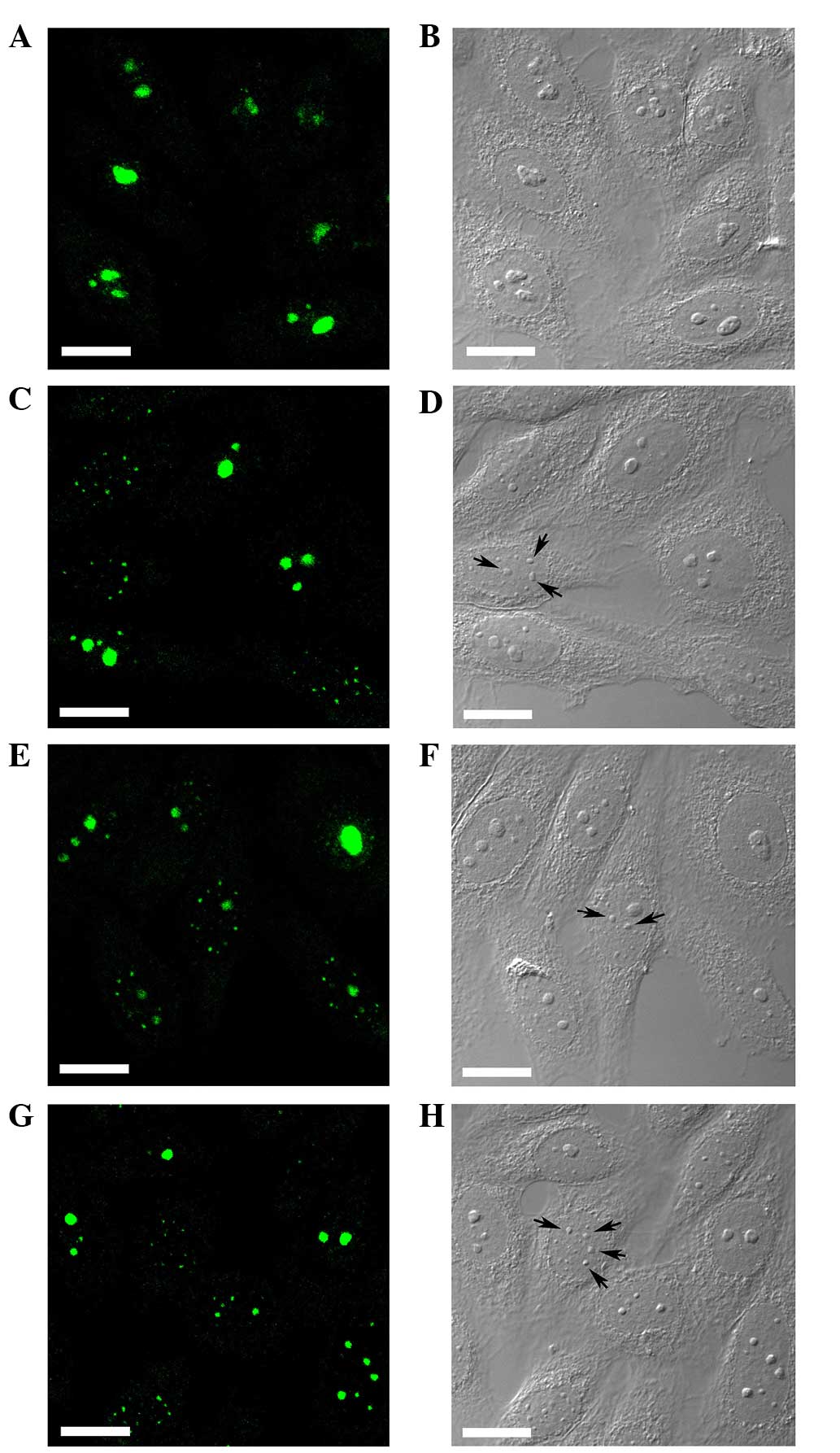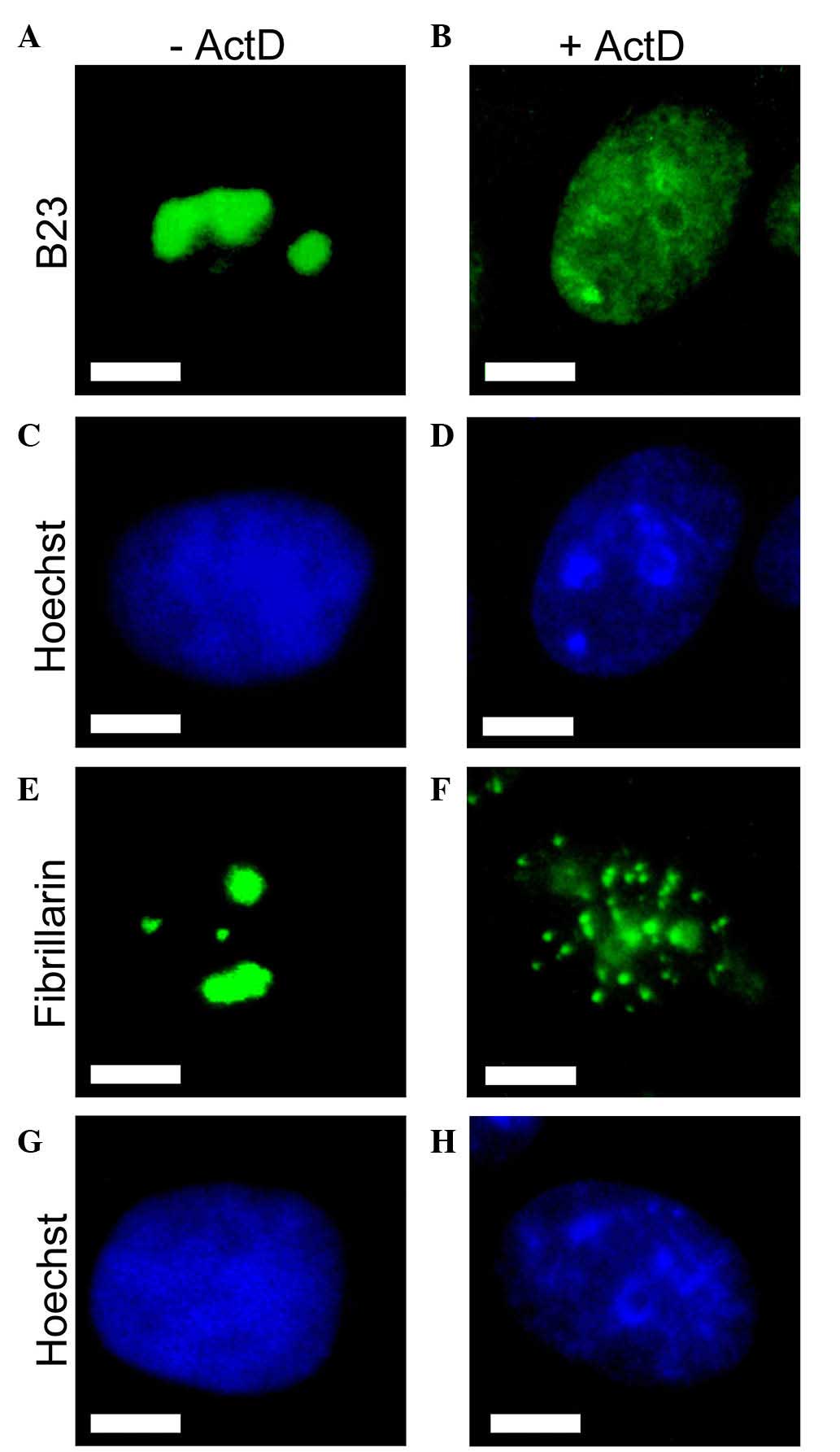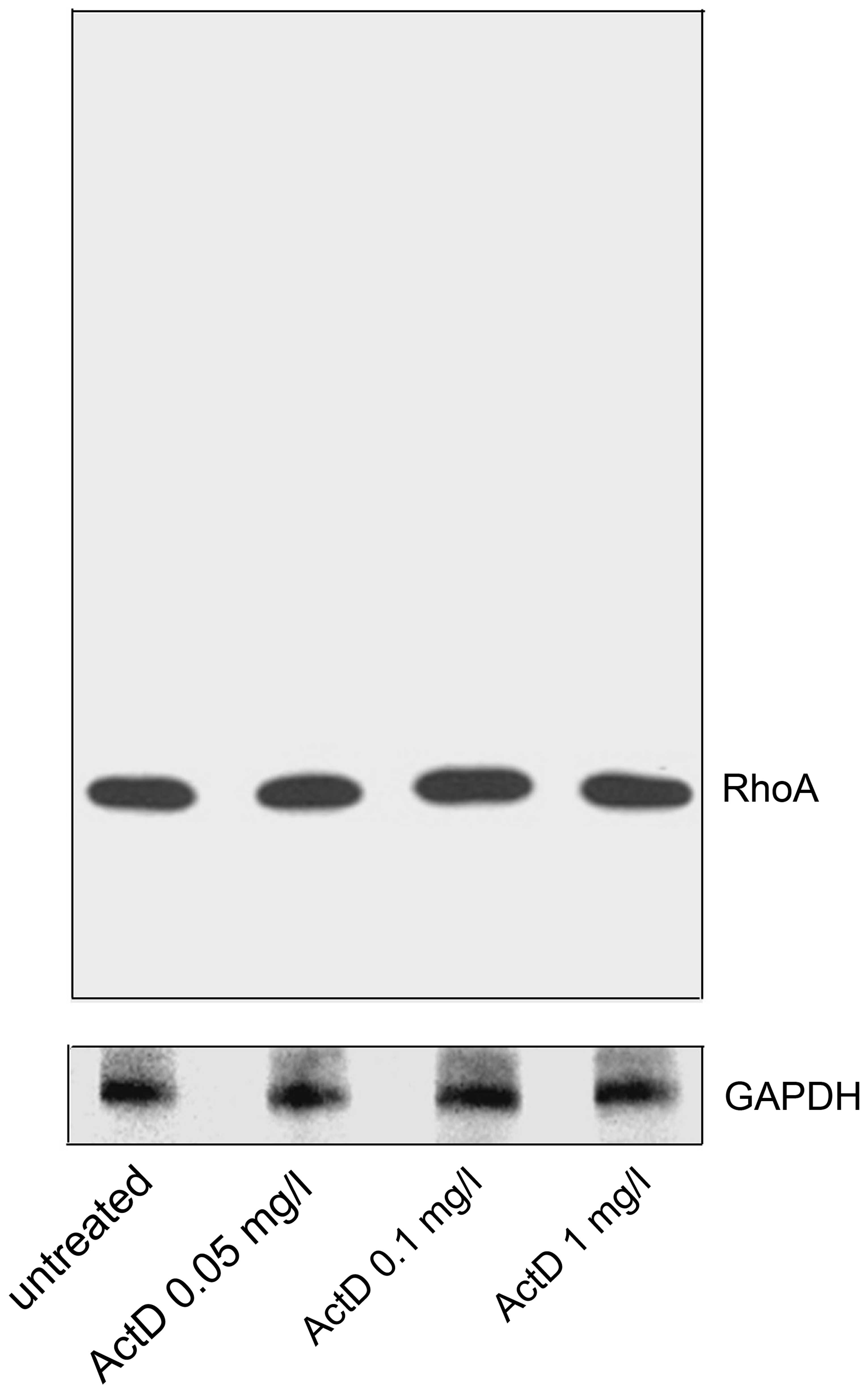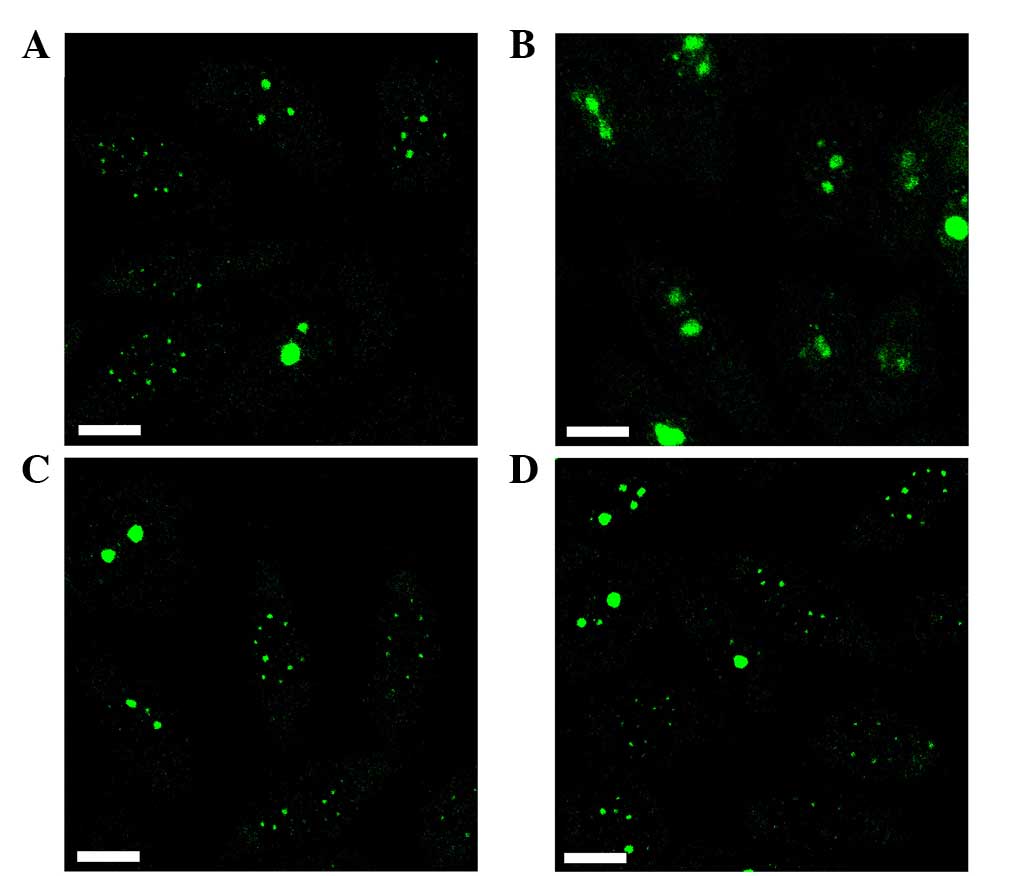|
1
|
Misteli T: Protein dynamics: Implications
for nuclear architecture and gene expression. Science. 291:843–847.
2001. View Article : Google Scholar : PubMed/NCBI
|
|
2
|
Scheer U, Thiry M and Goessens G:
Structure, function and assembly of the nucleolus. Trends Cell
Biol. 3:236–241. 1993. View Article : Google Scholar : PubMed/NCBI
|
|
3
|
Bártová E, Horáková AH, Uhlírová R, Raska
I, Galiová G, Orlova D and Kozubek S: Structure and epigenetics of
nucleoli in comparison with non-nucleolar compartments. J Histochem
Cytochem. 58:391–403. 2010. View Article : Google Scholar : PubMed/NCBI
|
|
4
|
Hernandez-Verdun D: The nucleolus today. J
Cell Sci. 99:465–471. 1991.PubMed/NCBI
|
|
5
|
Spector DL: Macromolecular domains within
the cell nucleus. Annu Rev Biochem. 9:265–315. 1993. View Article : Google Scholar
|
|
6
|
Shaw PJ and Jordan EG: The nucleolus. Annu
Rev Cell Dev Biol. 11:93–121. 1995. View Article : Google Scholar : PubMed/NCBI
|
|
7
|
Scheer U and Hock R: Structure and
function of the nucleolus. Curr Opin Cell Biol. 11:385–390. 1999.
View Article : Google Scholar : PubMed/NCBI
|
|
8
|
Muro E, Gébrane-Younís J, Jobart-Malfait
A, Louvet E, Roussel P and Hernandez-Verdun D: The traffic of
proteins between nucleolar organizer regions and prenucleolar
bodies governs the assembly of the nucleolus at exit of mitosis.
Nucleus. 1:201–211. 2010. View Article : Google Scholar
|
|
9
|
Pederson T: The plurifunctional nucleolus.
Nuclei Acid Res. 26:3871–3876. 1998. View Article : Google Scholar
|
|
10
|
Pederson T: The nucleolus. Cold Spring
Harb Perspect Biol. 3:a0006382011. View Article : Google Scholar : PubMed/NCBI
|
|
11
|
Mackay DJ and Hall A: Rho GTPases. J Biol
Chem. 273:20685–20688. 1998. View Article : Google Scholar : PubMed/NCBI
|
|
12
|
Sotiropoulos A, Gineitis D, Copeland J and
Treisman R: Signal-regulated activation of serum response factor is
mediated by changes in actin dynamics. Cell. 98:159–169. 1999.
View Article : Google Scholar : PubMed/NCBI
|
|
13
|
Kamai T, Yamanishi T, Shirataki H, Takagi
K, Asami H, Ito Y and Yoshida K: Overexpression of RhoA, Rac1, and
Cdc42 GTPases is associated with progression in testicular cancer.
Clin Cancer Res. 10:4799–4805. 2004. View Article : Google Scholar : PubMed/NCBI
|
|
14
|
Dubash AD, Guilluy C, Srougi MC, Boulter
E, Burridge K and García-Mata R: The small GTPase RhoA localizes to
the nucleus and is activated by Net1 and DNA damage signals. PloS
One. 6:e173802011. View Article : Google Scholar : PubMed/NCBI
|
|
15
|
Guilluy C, Dubash AD and García-Mata R:
Analysis of RhoA and Rho GEF activity in whole-cells and the cell
nucleus. Nat Protoc. 6:2050–2060. 2011. View Article : Google Scholar : PubMed/NCBI
|
|
16
|
Li YY, Chen YC and Xu J: Factors
influencing RhoA protein distribution in the nucleus. Mol Med
Report. 4:1115–1119. 2011.
|
|
17
|
Li YY, Chen YC, Tao Y, Xu J and Chen M:
RhoA protein is generally distributed in the nuclei of cancer
cells. Oncol Rep. 24:1005–1009. 2010.PubMed/NCBI
|
|
18
|
Xu J, Li Y, Yang X, Chen Y and Chen M:
Nuclear translocation of Small G protein RhoA via active
transportation in gastric cancer cells. Oncol Rep. 30:1878–1882.
2013.PubMed/NCBI
|
|
19
|
Perry RP and Kelly DE: Inhibition of RNA
sythesis by actinomycin D: Characteristic dose-response of
different RNA species. J Cell Physiol. 76:127–139. 1970. View Article : Google Scholar : PubMed/NCBI
|
|
20
|
Chen FM: Binding specificities of
actinomycin D to self-complementary tetranucleotide sequences
-XGCY-. Biochemistry. 27:6393–6397. 1988. View Article : Google Scholar : PubMed/NCBI
|
|
21
|
Biggiogera M, Fakan S, Kaufmann SH, Black
A, Shaper JH and Busch H: Simultaneous immunoelectron microscopic
visualization of protein B23 and C23 distribution in the HeLa cell
nucleolus. J Histochem Cytochem. 37:1371–1374. 1989. View Article : Google Scholar : PubMed/NCBI
|
|
22
|
Sweet P, Chan PK and Slater LM:
Cyclosporin A and verapamil enhancement of daunorubicin-produced
nucleolar protein B23 translocation in daunorubicin-resistant and
-sensitive human and murine tumor cells. Cancer Res. 49:677–680.
1989.PubMed/NCBI
|
|
23
|
Yung BY, Bor AM and Chan PK: Short
exposure to actinomycin D induced ‘reversible’ translocation of
protein B23 as well as ‘reversible’ inhibition of cell growth and
RNA synthesis in HeLa cells. Cancer Res. 50:5987–5991.
1990.PubMed/NCBI
|
|
24
|
Yao Z, Duan S, Hou D, Wang W, Wang G, Liu
Y, Wen L and Wu M: B23 acts as a nucleolar stress sensor and
promotes cell survival through its dynamic interaction with hnRNPU
and hnRNPA1. Oncogene. 29:1821–1834. 2010. View Article : Google Scholar : PubMed/NCBI
|
|
25
|
Benavente R, Reimer G, Rose KM, Hügle-Dörr
B and Scheer U: Nucleolar changes after microinjection of
antibodies to RNA polymerase I into the nucleus of mammalian cells.
Chromosoma. 97:115–123. 1988. View Article : Google Scholar : PubMed/NCBI
|
|
26
|
Puvion-Dutilleul F, Mazan S, Nicoloso M,
Pichard E, Bachellerie JP and Puvion E: Alteration of nucleolar
ultrastructure and ribosome biogenesis by actinomycin D.
Implications for U3 snRNP function. Eur J Cell Biol. 58:149–162.
1992.PubMed/NCBI
|
|
27
|
Rivera-León R and Gerbi SA: Delocalization
of some small nucleolar RNPs after actinomycin D treatment to
deplete early pre-rRNAs. Chromosoma. 105:506–514. 1997. View Article : Google Scholar : PubMed/NCBI
|
|
28
|
Chen M and Jiang P: Altered subcellular
distribution of nucleolar protein fibrillarin by actinomycin D in
HEp-2 cells. Acta Pharmacol Sin. 25:902–906. 2004.PubMed/NCBI
|
|
29
|
Boisvert FM, van Koningsbruggen S,
Navascués J and Lamond AI: The multifunctional nucleolus. Nat Rev
Mol Cell Biol. 8:574–585. 2007. View
Article : Google Scholar : PubMed/NCBI
|
|
30
|
Montanaro L, Treré D and Derenzini M:
Nucleolus, ribosomes, and cancer. Am J Pathol. 173:301–310. 2008.
View Article : Google Scholar : PubMed/NCBI
|
|
31
|
Hein N, Hannan KM, George AJ, Sanij E and
Hannan RD: The nucleolus: An emerging target for cancer therapy.
Trends Mol Med. 19:643–654. 2013. View Article : Google Scholar : PubMed/NCBI
|
|
32
|
Pianese G: Beitrag zur Histologie und
Aetiologie der Carcinoma. Histologische und experimentelle
Untersuchungen. Beitr Pathol Anat Allg Pathol. 142:1–193. 1896.
|
|
33
|
Quin JE, Devlin JR, Cameron D, Hannan KM,
Pearson RB and Hannan RD: Targeting the nucleolus for cancer
intervention. Biochim Biophys Acta. 1842:802–816. 2014. View Article : Google Scholar : PubMed/NCBI
|
|
34
|
Orgaz JL, Herraiz C and Sanz-Moreno V: Rho
GTPases modulate malignant transformation of tumor cells. Small
GTPases. 5:e290192014. View Article : Google Scholar : PubMed/NCBI
|
|
35
|
Pickard AJ and Bierbach U: The cell's
nucleolus: An emerging target for chemotherapeutic intervention.
Chem Med Chem. 8:1441–1449. 2013. View Article : Google Scholar : PubMed/NCBI
|
|
36
|
Ochs RL: Methods used to study structure
and function of the nucleolus. Methods Cell Biol. 53:303–321. 1998.
View Article : Google Scholar : PubMed/NCBI
|
|
37
|
Xu K and Ludueña RF: Characterization of
nuclear betaII-tubulin in tumor cells: A possible novel target for
taxol. Cell Motil Cytoskeleton. 53:39–52. 2002. View Article : Google Scholar : PubMed/NCBI
|
|
38
|
Howard J and Hyman AA: Dynamics and
mechanics of the microtubule plus end. Nature. 422:753–758. 2003.
View Article : Google Scholar : PubMed/NCBI
|


















